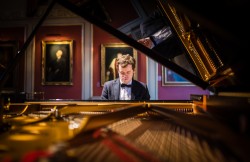 On Tuesday, November 7, the remarkable British pianist Benjamin Grosvenor made his third appearance on Music Toronto’s Jane Mallett Theatre stage since February 2014, to the delight of a large and appreciative audience.
On Tuesday, November 7, the remarkable British pianist Benjamin Grosvenor made his third appearance on Music Toronto’s Jane Mallett Theatre stage since February 2014, to the delight of a large and appreciative audience.
Grosvenor’s exceptional talent was revealed at the age of 11, when he won the keyboard section of the BBC Young Musician of the Year. At 19, he became the first British pianist in more than six decades to be signed to a recording contract by Decca. Shortly thereafter, he was the youngest soloist to perform at the First Night of the Proms in London. Gramophone magazine named him its Young Artist of the Year in 2012. Today, at 25, Grosvenor is in the vanguard of the new generation of pianists, in the company of the likes of Daniil Trifonov, Yuja Wang and Jan Lisiecki.
Grosvenor is a unique creator of sound worlds, attentive and nuanced – a riveting performer with keen musical insights which his effortless and prodigious technique affords.
From the opening notes of Mozart’s Piano Sonata in B-flat Major, K333, the mood was set as Grosvenor invited us into a self-contained world of tone colour and dynamic balance, of sparkling and well-shaped phrases that conveyed the composer’s musical structure. The middle movement was marked by the pianist’s singing tone and a delicacy built on strength, typified by a hush in the development section. The Allegretto grazioso exuded Mozartean joy and playfulness, leading to a cadenza that showcased Grosvenor’s brilliant technique. It would not be the last time that technique – and not just for its own sake – would be evident.
Grosvenor’s program then jumped ahead to four – “seminal works” he called them in a recent email exchange with me – written within two decades spanning the end of the 19th and beginning of the 20th centuries. Brahms’ Four Pieces for Piano, Op.119, his final compositions (comprising three intermezzos and a rhapsody), alternated with Brett Dean’s three-part Hommage à Brahms, managing at times to look forward, at times back. Grosvenor played the first Brahms Intermezzo very slowly, its nostalgic, dreamy beginning emphasizing the harmonic progression, occasionally drawing out the chords by breaking them. Dean’s Engelsflügel 1, which followed, began impressionistically before entering into a conversation with our memory of the Brahms. Grosvenor brought a fine sense of control to the second Intermezzo, allowing its lovely lyrical melody to grow organically, followed by the boisterous energy of Dean’s second piece, Hafenkneipenmusik. The third Brahms Intermezzo picked up some of the bits of whimsy present in Dean’s writing, before Grosvenor’s unerring sense of grace balanced Brahms’ strong chord progressions. Grosvenor’s light touch brought out the spellbinding modernism of Dean’s final Engelsflügel 2, before the grand climax of Brahms’ Rhapsody brought the section to a triumphal close.
Grosvenor widened his tonal palette in Leonard Borwick’s arrangement of Debussy’s pivotal Prélude à l'après-midi d'un faune – a piece Pierre Boulez called the beginning of modern music – a colouristic tour de force. Berg’s Piano Sonata, Op.1 came next, given an astounding interpretation, a forceful, romantic, totally engaged, propulsive, yearning, tender, ardent chordal jamboree. Ravel’s atmospheric three-part Gaspard de la nuit followed, with Ondine and its rigorous dynamism, massive wave-upon-wave impressionism, tender glissando and double arpeggios displayed with unalloyed fluency. The colourist in Grosvenor came to the fore
in the mysterious, inscrutable Le Gibet before expanding in the demonic Scarbo to every hue in a dark rainbow, shaped with a raison d’être that was far more than a blurred handful of whirling notes.
His next visit cannot come soon enough.
Pianist Benjamin Grosvenor was presented in recital by Music Toronto on November 7, at Toronto’s Jane Mallett Theatre.
Paul Ennis is the managing editor of The WholeNote.


